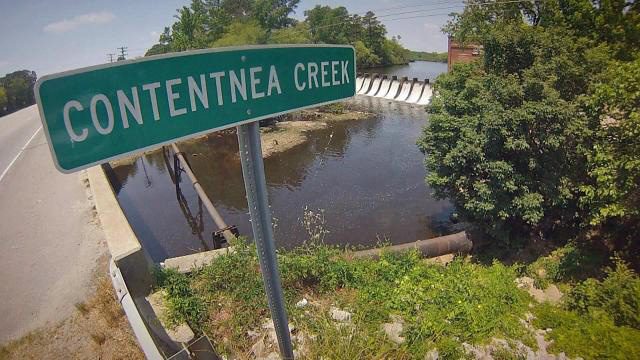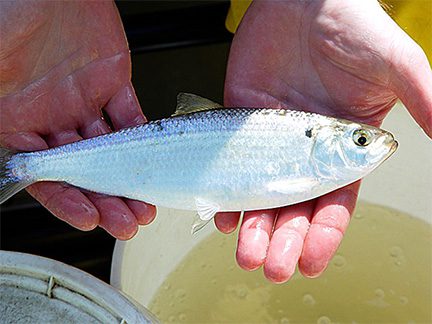By DREW C. WILSON, The Wilson Times via The Associated Press
STANTONSBURG, N.C. — A couple miles upstream from the N.C. 222 bridge, Ben Ricks begins an exploratory survey of fish on the Contentnea Creek.
Ricks, the District 2 fisheries biologist for the N.C. Wildlife Resources Commission, uses an electrofishing boat that sends a pulsing current into the water through dangling anodes.
The shock stuns the fish temporarily, leaving enough time for them to be scooped out of the water with a net and held in a basin to be weighed and measured.
“In five or 10 minutes, they are back to normal,” Ricks said.
Ricks is pleased to see that the first fish to come to the surface and caught is an alewife herring.
Alewife herring and blueback herring have been under a moratorium since 2006.
ON THE REBOUND
“I haven’t really sampled this particular stretch of Contentnea Creek a whole lot, so it is neat for me to show up at a spot like this and relatively easily get one of the species of interest for us,” Ricks said. “We knew there were shad here, but to get an alewife at an area I had never been to, that just makes for a good day for us.”
Capturing alewife early in March is an important data point that shows herring are still using the Contentnea Creek the way that they used to, said Ricks, who is also the president of the American Fisheries Society’s North Carolina Chapter.
“She’s already spawned some because she’s not real fat-bellied,” Ricks says as he pushes a tiny clump of eggs, or roe, out of the 11-inch-long fish to determine it is a female.
The herring fishery in North Carolina was once one of the largest fisheries in the world, with some 20 million pounds harvested commercially in 1970.
Ricks said the herring population is starting to see a little bit of benefit from the moratorium.
“The more information we have about where these fish are, the better we can conserve them as we move into the future,” he said.
CREEK’S HEALTH
The Contentnea Creek winds its way for 34 miles from the dam at Buckhorn Reservoir through western and southern Wilson County by way of the Wiggins Mill Reservoir and dam and then to Stantonsburg, where it continues into Greene County. The waterway eventually dumps into the Neuse River.
“Most of the other tributaries don’t have nearly the flow into the Neuse that Contentnea has,” Ricks said.
Ricks said the recent cleanup of logs and debris in the creek led by the Wilson County Soil and Water Conservation District was also important for navigation.
“This is kind of a pristine creek, and for folks to be able to paddle it and ride boats up and down it, you’ve got to get that stuff out of the way,” Ricks said.
Ricks nudges the bow of the boat into the mouth of a narrow streamlet shooting off the main creek.
As the pulsing effect of the electric anodes is felt, a dozen or more hand-sized largemouth bass and sunfish rise to the surface, allowing the netter to scoop up seven or eight in one drag across the water.
It’s an indication of the Contentnea Creek’s good health.
“We have got the whole host of resident sport fish, which would be largemouth bass, the collection of sunfish species of which most are bluegill, shellcracker, warmouth, black crappie and redbreast,” Ricks said.
“We also have catfish species. The native ones would be the white catfish and the bullheads,” Ricks said. “A lot of people don’t realize that the bullheads and the white cats are our only native catfish. If you went back to pre-Colonial days, that’s what you would find here.”
“We saw plenty of American shad. The gars and the other non-target fish, they seem to be here in decent numbers, or what we would expect to see for this time of year, so all in all, it’s in pretty decent shape. Today is just a snapshot, but it gives us a decent view of what’s going on here.”
CREEK PRESERVATION
Ricks said it’s important for people to understand the mechanics of places like the Contentnea Creek.
“Contentea Creek is one of the last places where there are certain madtom species, which is a small native catfish,” Ricks said. “It’s one of the last kind of holdouts for that species in the whole Neuse River system. Because of that, it is important to understand if those habitats are in good shape or bad shape. Are they being degraded? Are they being improved?”
Ricks said the main thing is for anglers, boaters and swimmers to be conscientious of how they’re using the creek.
“Obviously you don’t want to litter and trash up the bank, but at the same time, if you are a land manager, you want to try to do things to avoid erosion as best you can,” Ricks said. “If you are out here fishing, you want to make sure that you are obeying the rules that are out there.”

